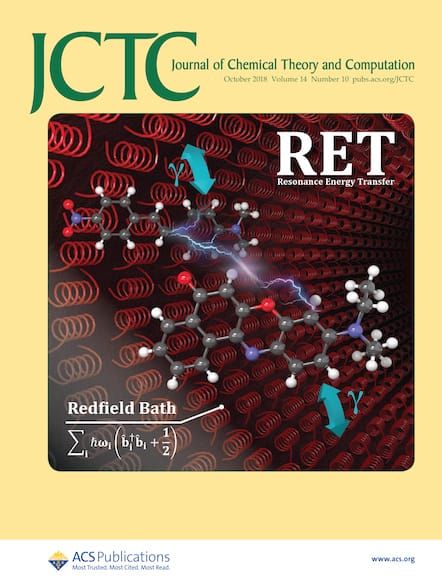基于时变密度泛函理论计算的介电屏蔽距离分离杂化泛函激发态能量分解分析。
IF 5.5
1区 化学
Q2 CHEMISTRY, PHYSICAL
引用次数: 0
摘要
控制低洼激发态的排列是分子设计工作的核心,旨在提高目标光电应用的性能。通常,这些态的能量是由最高已占据分子轨道(HOMO)和最低未占据分子轨道(LUMO)之间的间隙决定的,相对于三重态(T1),交换排斥使最低单重态(S1)不稳定。然而,通过合理的分子设计,S1-T1能隙可以最小化──甚至反转。这种激发态场景可以实现热激活延迟荧光(TADF)等机制,从而提高发光效率。在这项工作中,我们将能量分量分析应用于时变DFT (TDDFT)计算的激发态,以更好地了解介电环境对S1和T1态能量的作用。分析使用SRSH-PCM方法进行,该方法通过将介电筛选范围分离混合(SRSH)函数与极化连续模型(PCM)相结合,提供了一致的环境影响处理方法。我们通过分析与光电子学相关的三个代表性分子系统的激发态特性来证明这种方法的实用性。我们的研究结果为控制激发态对齐和耦合的能量趋势提供了有价值的见解,这是优化相关应用效率的关键。本文章由计算机程序翻译,如有差异,请以英文原文为准。
Energy Decomposition Analysis of Excited States Based on Time-Dependent Density Functional Theory Calculations Employing a Dielectric-Screened Range-Separated Hybrid Functional.
Controlling the alignment of low-lying excited states is central to molecular design efforts aimed at improving the performance in targeted optoelectronic applications. Typically, the energies of these states are governed by the gap between the highest occupied molecular orbital (HOMO) and the lowest unoccupied molecular orbital (LUMO), with exchange repulsion destabilizing the lowest singlet state (S1) relative to the triplet (T1). However, through rational molecular design, the S1-T1 energy gap can be minimized─or even inverted. Such excited-state scenarios can enable mechanisms like thermally activated delayed fluorescence (TADF), which enhance the light-emission efficiency. In this work, we apply energy component analysis to time-dependent DFT (TDDFT) calculated excited states to better understand the role of the dielectric environment on S1 and T1 state energies. The analysis is performed using the SRSH-PCM approach, which provides a consistent treatment of environmental effects by combining a dielectric-screened range-separated hybrid (SRSH) functional with a polarizable continuum model (PCM). We demonstrate the utility of this approach by analyzing the excited-state properties of three representative molecular systems relevant to optoelectronics. Our results offer valuable insight into energy trends governing the alignment and coupling of excited states, which are key to optimizing efficiency in relevant applications.
求助全文
通过发布文献求助,成功后即可免费获取论文全文。
去求助
来源期刊

Journal of Chemical Theory and Computation
化学-物理:原子、分子和化学物理
CiteScore
9.90
自引率
16.40%
发文量
568
审稿时长
1 months
期刊介绍:
The Journal of Chemical Theory and Computation invites new and original contributions with the understanding that, if accepted, they will not be published elsewhere. Papers reporting new theories, methodology, and/or important applications in quantum electronic structure, molecular dynamics, and statistical mechanics are appropriate for submission to this Journal. Specific topics include advances in or applications of ab initio quantum mechanics, density functional theory, design and properties of new materials, surface science, Monte Carlo simulations, solvation models, QM/MM calculations, biomolecular structure prediction, and molecular dynamics in the broadest sense including gas-phase dynamics, ab initio dynamics, biomolecular dynamics, and protein folding. The Journal does not consider papers that are straightforward applications of known methods including DFT and molecular dynamics. The Journal favors submissions that include advances in theory or methodology with applications to compelling problems.
 求助内容:
求助内容: 应助结果提醒方式:
应助结果提醒方式:


